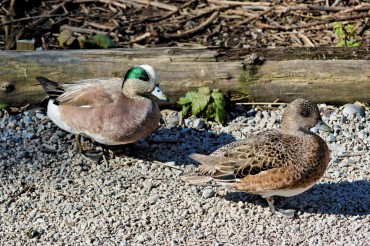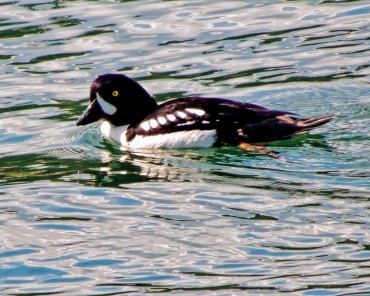
The middle of winter can be the perfect time for a stroll along the many waterfront areas found throughout West Sound country. Choose a day when the weather offers clear, blue skies and crisp, cool temperatures. Birds sheltering in inland waters react to such a day as if spring were just around the corner. Lengthening days, coupled with brilliant sunlight, encourage ducks that will nest in the far north to begin showing off their colors to one another.
All of the birds wintering on West Sound waters aren’t ducks but they are the birds that make winter birdwatching entertaining. Goldeneyes, scaup, long-tailed ducks, scoters, bufflehead and wigeon winter here by the thousands. Any beach you walk along can have them practicing the courting antics they will perform during spring breeding season. These are more intricate than you might expect.
The small bufflehead duck is reputed to have been given its common name due to the size of its head. It is rounded and appears large compared to the bird’s body. “Buffalo head” was an early common name.
These are wonderful little ducks that do everything with their “throttles” wide open. They not only fly like rockets but their take-offs and landings are spectacular. There is nothing gradual about the way they take flight. No pattering along the water with wings pumping furiously. Instead, they shoot from their bottoms straight into the air. These are one of the ducks that offer hunters all the challenge they want.
A bufflehead landing is equally impressive. They come in hot and hit the water with both feet held out in front of them — as if they were water-skiing. Their bodies are military-parade straight, with heads held slightly backward. Totally pleased with this performance, the male birds sport about the water’s surface looking as if they had an outboard motor attached to their tails.
Male goldeneye ducks are one of the most handsome ducks seen on winter waters. Except for their yellow eyes, they wear black-and-white tuxedoes. When sunlight highlights the male Barrow’s plumage, a purplish sheen can be seen.
The same is true for the common male goldeneye but it has a greenish cast. Goldeneye frequently gather in small groups near the water’s edge, in places where fresh water enters saltwater. This estuarine habitat contains food to their liking. The beach near Poulsbo’s Lions Club Park on Liberty Bay is one of their popular feeding and socializing spots.
Winter courtship displays are performed by both males and females. Male ducks perform highly ritualized gestures that resemble an attack. This is to discourage other males. The female’s display is a form of enticement when she is attracted to a male. Head-pumping movements and neck-stretching motions are also part of these displays. One of the most interesting is a head throw toward the bird’s back while it delivers a backward kick and splash. To attract a goldeneye mate, it helps to be in good shape.

When it comes to bird entertainment during the winter months, scoters are a common sight throughout the West Sound. Port Orchard’s waterfront can have hundreds, even thousands of ducks feeding in the protected waters. Where surf scoters or white-winged scoters gather in large numbers, the action is nonstop.
Clear, cold winter days encourage the males to take part in what looks like a bachelor party. The females seem bored with these antics and float about looking at nothing in particular. The males, on the other hand, appear to take offense at any male near their space. Their splashing resembles a group of youngsters enjoying a water fight.
Not all of these performing ducks lean toward black or black-and-white plumage. The dainty wigeon that gather in the thousands along the Port Orchard waterfront sport several colors. Male American wigeon wear a white crown down the center of their heads. This color pattern is responsible for one of their earlier common names. Hunters still refer to them as “baldpates.” Green, chestnut and gray complete their plumage colors.
When a flock of American wigeon is spotted, it pays to take a second look and see if there are any Eurasian wigeon in the group. Look for the male’s chestnut-colored head with its buff-colored “pate.” These are a rare find but numerous sightings occur every winter.
Wigeon are “talkative” ducks. You can hear them even before you see them. The males make a “whee, whee, whew” whistling sound and call back and forth nonstop. Even when flying, the wind passing through their wings whistles.
One of the really handsome ducks seen during the winter is the long-tailed duck. While most of our ducks shelter in protected saltwater areas, this one prefers more open water. It belongs to a group known as sea ducks. Open water off the northern tip of the Kitsap Peninsula as well as off Bainbridge Island’s Fay Bainbridge State Park are two places where this handsome duck might be seen.
Even though we are well into winter, the days are getting longer and this has an effect on winter water birds. They know we’ve turned the corner and spring is getting closer. Their prenuptial posturing on days when the sun is out is evidence of that. It also means a winter walk is an opportunity to enjoy some winter fun at the water’s edge.

























